#Adam and Hoffman buddy comedy show when?
Explore tagged Tumblr posts
Text
Chainshipping Prompt #2:
Adam’s ghost full on haunts the shit out of John until John agrees to leave Lawrence alone.
But wait, there’s more.
Adam was never dead, he just made a deal with Hoffman to smuggle him out of the bathroom to fuck with John. Dead guy in the bathroom is actually some no name asshole who got Hoffman’s coffee order wrong. (He’ not being petty, honest). He and Hoffman work together to con John.
Pro for Hoffman, Larry is out of the picture now, and he doesn’t have to worry about competition for John’s legacy. Con: he has to fucking work with Adam. Why is this guy so insufferable. (If he starts to be reminded of Angelina because of Adam’s terrible taste in music that’s no one’s business but his own. Also he’s kinda lowkey pissed that Amanda tried to kill this guy. Like WTF Mandy, Adam was never going to be John’s favorite anyway).
Adam meanwhile see’s no con’s only pro’s.
He get’s to mess with Hoffman (man is unintentionally the funniest fucker alive - I mean, who thinks that the best way to flirt with the guy is to try to drown him? Not fucking Adam, that’s for sure), He get’s to fuck with Kramer (Thank you John Rogers for giving him Leverage - AKA his conning bible, even if Hoffman think’s it’s stupid as hell), and he get’s to get Larry away from that guy. If he’s stuck in a roommate comedy with Hoffman until he can actually tell his doctor he’s alive, again, Adam see’s no cons in that.
Lawrence is sure in for a shock when he wakes up in an unfamiliar apartment to Adam and Hoffman in a screaming match while FBI agent Mr. supposed-to-be-dead!Peter Strahm is listening to them with his head in his hands, every so often shaking his head. “Why did I have to fall in love with the fucked up idiot? Why did I do that to myself?” —> Or Hoffman really thought the best way to clue Lawrence into Adam’s very alive state was to drug him and bring him back to his apartment.
#It’s the Roommate AU no one asked for but I sure as heck need#Adam and Hoffman buddy comedy show when?#Adam is the worlds worst hype man so Strahm is just going to have to admit that he’s a little fucked up too.#He did get in that fucking glass coffin after all#timeline? What timeline??!#Amanda and John Kramer being conned by Adam and Hoffman is something that can be so personal#chainshipping#coffinshipping#lawrence gordon#mark hoffman#peter strahm#adam faulkner stanheight#saw#YOU KNOW WHAT?#leverage au
64 notes
·
View notes
Text
CURTAIN UP!
Lucy On Stage ~ Act 3
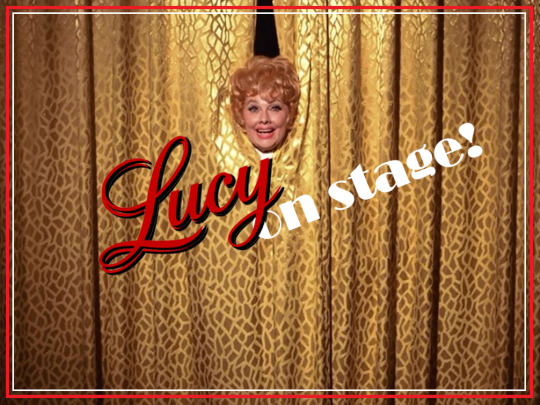
Lucille Ball’s dream was to appear on Broadway. That dream become a reality in 1960, but ended prematurely. if Lucy couldn’t be on Broadway, Broadway would come to Hollywood – on Lucy’s new TV show “Here’s Lucy.”
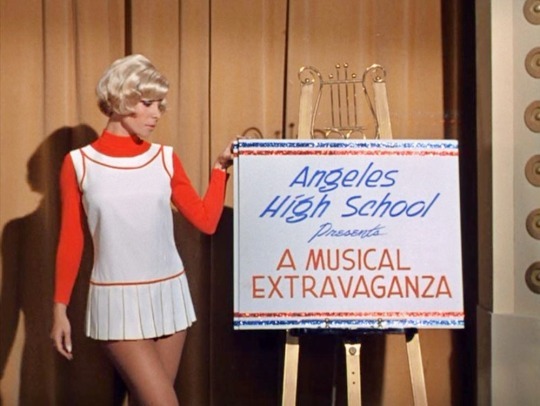
“A MUSICAL EXTRAVAGANZA”
“Lucy and Carol Burnett” (1969) ~ Lucy convinces Carol Burnett to star in a benefit to raise money to build a gymanasium at Kim and Craig’s high school. The show is divided into three parts:

PART I - WE GOT NO GYM (Introduction)
“Yes! We Have No Gymnasium” (aka “Yes! We Have No Bananas”) was written by Frank Silver and Irving Cohn from the 1922 Broadway revue Make It Snappy.
Carol does a brief time step to the melody of “There’s No Business Like Show Business,” a song written by Irving Berlin for the musical Annie Get Your Gun.

PART II - WE GOT THE MONEY (a visual lesson in geography)
NEW YORK, NY ~ “The Lullaby of Broadway” was written by Harry Warren and Al Dubin. It was introduced musical film Gold Diggers of 1935 and won the Academy Award for Best Original Song. The song is now part of the Broadway musical 42nd Street.
ST. LOUIS, MO ~ “You Came a Long Way From St. Louis” by John Benson Brooks and Bob Russell.
SHEBOYGAN, WI - “Mention My Name in Sheboygan” was written by Bob Hilliard, Dick Sanford and Sammy Mysels in 1947. The second verse mentions NEW ORLEANS and the third TEXAS.

PART III - WE GOT OUR GYM (a celebration of physical education)
A marching band plays “Buckle Down, Winsocki” from the 1943 film Best Foot Forward in which Lucille Ball played herself.
Craig sings “You Gotta be a Football Hero (To Get Along with the Beautiful Girls)” by Al Sherman, Buddy Fields and Al Lewis in 1933.
Kim sings “All American Girl” written by Al Lewis in 1932.
A display of gymnastics in which Harry (Gale Gordon) does a cartwheel.
The finale is “Fit as a Fiddle” written by Arthur Freed, Al Hoffman, and Al Goodhart in 1932. In 1952 it achieved fame after being featured in the classic film Singin’ in the Rain.
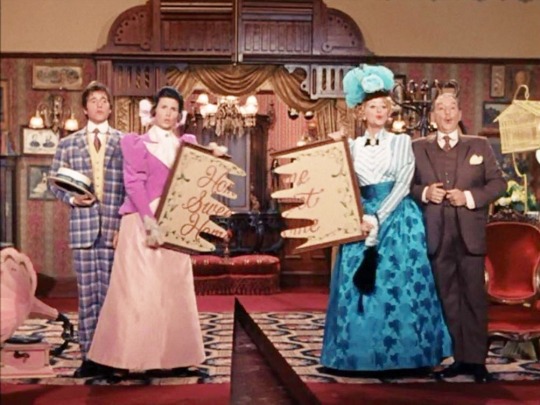
“THE GENERATION GAP THROUGH THE AGES”
“Lucy and the Generation Gap” (1969) ~ Kim and Craig are in charge of producing the school play. At a loss for ideas, they recruit Lucy and Harry to be in a musical about the generation gap. The show is divided into three parts:

The Roman Era
Lucy and Harry play parents Calpurnia and Caesar. Kim is their daughter Kimea and Craig is their son Craigius. They sing “Kids Are Bugged About Parents” to the tune of “I’m Just Wild About Harry,” a song written in 1921 by Eubie Blake for the Broadway show Shuffle Along.

In The Gay Nineties
Harry plays Ambrose, the father. Lucy and the kids don’t get different names in this segment. The foursome sing “We’ll Just Cut the Old House in Two” which is sung to the tune of “Bicycle Built for Two” aka “Daisy Bell” written in 1892 by Harry Dacre.

In The Space Age
Kim wants to go to Jupiter with Spencer. When Lucy refuses because it is an overnight trip, Lucie reasons that Helen’s mother lets her go. Harry points out that Helen’s mother is a robot – and always “well-oiled.” They sing “Kids” a song written by Lee Adams and Charles Strouse for the 1960 Broadway musical Bye Bye Birdie, filmed in 1963.
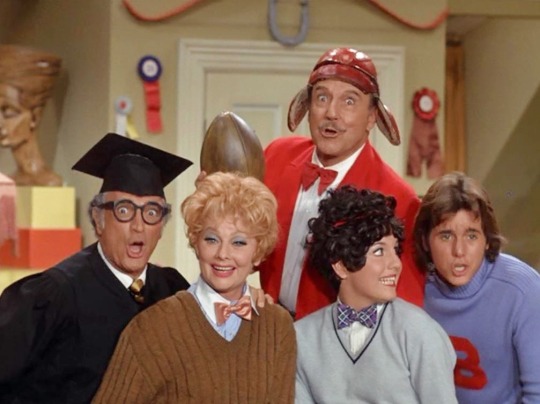
“IT’S ALWAYS DO-WACKA-DO AT BULLWINKLE U!”
“Lucy the Co-Ed” (1970) ~ Harry's old flame Gloria (Marilyn Maxwell) is in town to help produce a musical for their college alumni. They resurrect a show Harry wrote in 1928 and cast Lucy, Kim, and Craig in supporting roles.
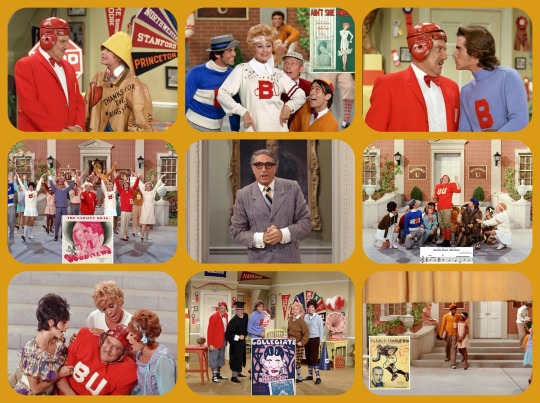
The musical comedy is set at Bullwinkle University. The cast includes Lucy as Ginger the head cheerleader, Harry as Crazy Hips the football star, Kim (Lucie Arnaz) as Honey, Craig (Desi Arnaz Jr.) as Dead End, Gloria (Marilyn Maxwell) as the Nurse, and Robert Alda as the Dean.
As the curtain goes up, the orchestra plays “You Gotta be a Football Hero (To Get Along with the Beautiful Girls)” written by Al Sherman, Buddy Fields and Al Lewis in 1933.
As Ginger (Lucy) enters, the boys sing “Ain't She Sweet” written in 1927 by Milton Ager and Jack Yellin.
When Crazy Hips (Harry) enters in his football uniform the girls sing “Baby Face” written in 1926 by Harry Akst and Benny Davis.
The students all sing “Buckle Down Bullwinkle” to the tune of “Buckle Down Winsockie” a song written for the film Best Foot Forward (1943) in which Lucille Ball did a cameo as herself.
Ginger, Honey, Dead End, Crazy Hips, and the Dean (Robert Alda) sing “Collegiate” written in 1925 by Nat Bonx and Moe Jaffe.
The musical ends with “Varsity Drag,” a song written by Lew Brown and B.G. DeSylva for Good News, which was seen on Broadway in 1927 and on screen in 1947 when it was nominated for an Academy Award for Best Song.
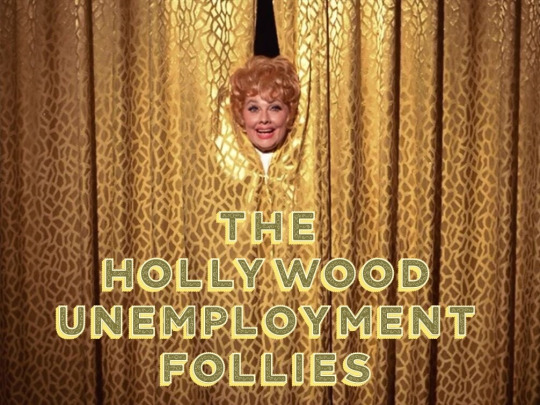

“THE HOLLYWOOD UNEMPLOYMENT FOLLIES or HOW TO STARVE IN SHOW BUSINESS WITHOUT REALLY TRYING”
“Lucy and Carol Burnett Salute Hollywood” (1971) ~ Harry has fired Lucy again, so she visits the unemployment office where she reunites with secretary turned actress Carol Krausmeyer (Carol Burnett) and meets other out of work show biz folk. They decide to put on a show in order to make some dough!
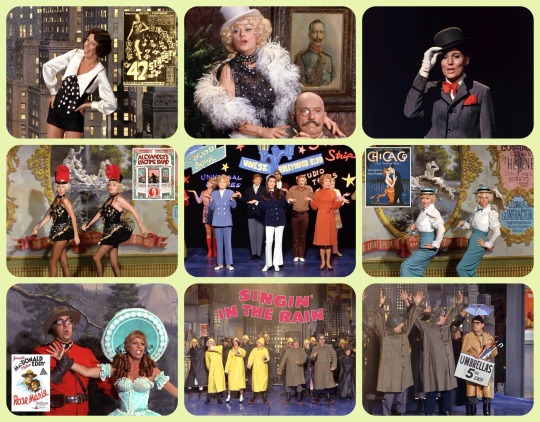
The ensemble sings “Hooray for Hollywood” a song by Johnny Mercer and Richard A. Whiting that was first sung in the 1937 movie Hollywood Hotel.
After a backstage tour of Hollywood memorobilia, Lucy and Carol sing “Chicago (That Toddlin’ Town”) a song written by Fred Fisher and published in 1922.
After a quick costume change, they sing “Alexander’s Ragtime Band” which was composer Irving Berlin’s first hit in 1911.
Kim introduces (through song) Bill ‘Bojangles’ Robinson doing a tap routine which she joins in.
Four Canadian Mounties sing “Stout-hearted Men,” a song by Sigmund Romberg and Oscar Hammerstein II written for the operetta New Moon in 1927, with film versions in 1930 and 1940. Richard Deacon (also dressed as a Mountie) and Carol Burnett sing “Indian Love Call” by Rudolf Friml, Herbert Stothart, Otto Harbach, and Oscar Hammerstein II written for the 1924 operetta Rose-Marie.
Dressed as Marlene Dietrich, Lucy sings “Falling in Love Again (Never Wanted To)” from the 1930 German film The Blue Angel. Harry plays a World War I German soldier.
The Highhatters introduce Carol as Miss Ruby Keeler and they sing “Shuffle Off To Buffalo” by Al Dubin and Hugh Warren, originally written for the 1933 film 42nd Street.
As the finale, the entire ensemble is dressed in rain slickers and performs “Singin’ in the Rain” written by Arthur Freed and Nacio Herb Brown in 1931. It was most famously featured in the film Singin’ in the Rain in 1952. Jack Benny makes a cameo appearance selling umbrellas!

“THE FAREWELL SHOW”
“Lucy Goes Hawaiian: Part 2″ (1971) ~ Lucy and Harry have to put a ‘Farewell Show’ for the final night of their cruise. Viv, Kim and Craig are along to help her to produce a Hawaiian extravaganza.

Dressed as a canary, Vivian sings "Yellow Bird” (aka “Choucoune”) a 19th-century Haitian song composed by Michel Mauleart Monton with lyrics from a poem by Oswald Durand. It was rewritten with English lyrics in the 20th century as “Yellow Bird.”
Kim and Lucy sing “Ukulele Talk” by Ervin Drake, written in the 1920s.
Craig does an impression of Don Ho (inset), singing “Tiny Bubbles” by Martin Denny and Leon Pober. It was released in 1966 by Ho and became his signature song.
Lucy and Viv sing the 1957 novelty song “Mama’s Mumu” by Gene Burdette. Harry makes a special appearances as 'Mama’.
The Captain (Robert Alda) sings “Just Keep Your Eyes on the Hands” while Kim dances a seductive hula. The song was written by Tony Todaro and Liko Johnston and was interpolated into the 1956 film The Revolt of Mamie Stover.
The Carters perform “A Hawaiian War Chant,” written by Johnny Noble, a composer who was a native Hawaiian.

“Lucy and Candid Camera” (1972) ~Thinking they are pulling off a Candid Camera stunt, Lucy, Harry and Kim rob the City Bank. The crime is done while performing a Broadway Musical song and dance medley especially written for this episode:
“Stealin' the Jack” aka “Ballin' the Jack” was written in 1913 by Jim Burris and Chris Smith.
“Hello, Dollar!” aka “Hello, Dolly!” is the title song of the 1964 musical of the same name written by Jerry Herman.
“Whatever Lucy Wants” aka “Whatever Lola Wants” is by Richard Adler and Jerry Ross from the 1954 musical Damn Yankees.
“We Got the Money” aka “We're in the Money or The Gold Diggers Song” was written by Al Dubin and Harry Warren for the film The Gold Diggers of 1933. It is now part of the stage musical 42nd Street.
“The Impossible Dream or The Quest” was written by Joe Darien and Mitch Leigh for the 1964 musical Man of La Mancha.
“Please Don't Talk About Us When We Go” aka “Please Don't Talk About Me When I'm Gone” was written by Sidney Clare and Sam H. Stept in 1930.
“Hey Look Me Over” written in 1960 by Cy Coleman for the Broadway musical Wildcat and introduced by Lucille Ball.
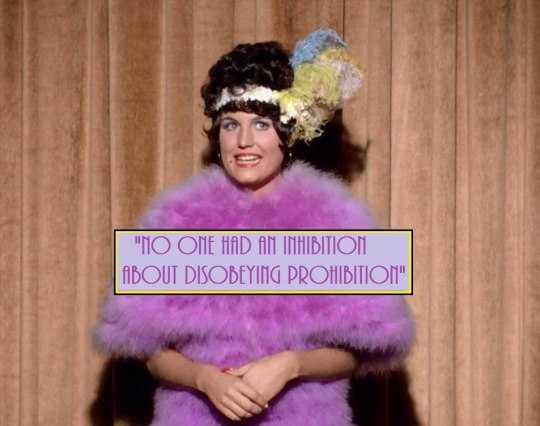
“NO ONE HAD AN INHIBITION ABOUT DISOBEYING PROHIBITION”
“My Fair Buzzi” (1972) ~ Kim’s shy and awkward friend Annie Whipple (Ruth Buzzi) comes out of her shell in order to audition for a 1920s revue. The episode title and story of transformation were inspired by the 1956 Broadway musical and 1964 film My Fair Lady, which, in turn, was inspired by George Bernard Shaw’s 1912 play Pygmalion. Both plays are mentioned in the dialogue of the episode.

In a rehearsal hall sequence, Kim performs “El Cubanchero,” one of Desi Arnaz’s biggest hits. It was written in 1947 by Rafael Hernández. When the director tells her that they are only working on the “Speakeasy” sketch, she offers a tap routine while singing “Anchor’s Aweigh,” the march of the United States Navy composed in 1906 by Charles A. Zimmermann.
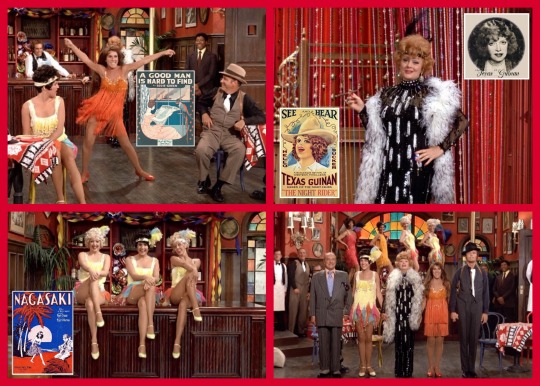
Kim and Annie are members of the Community Drama Club. Lucy plays Dallas Noonan, a reference to real-life Texas Guinan, one of the first female emcees and speak easy owners. Annie plays Penelope, Harry plays gangster Big Jake, and Kim plays dancer Buttercup.
Buttercup and two flappers appear as ‘The Misstep Sisters’ and tap and sing to “Nagasaki,” a song written in 1928 by Harren Warren and Mort Dixon.
For the curtain call, the band plays “Tiger Rag,” a song that dates back to 1917.

“THE GIRL FRIDAY FOLLIES”
“Lucy Gives Eddie Albert the Old Song and Dance” (1973) ~ When producing a charity show, Lucy asks Eddie Albert to star in it. At the same time, a woman meeting Lucy’s description has been stalking Albert.
The show a show (which raises money to send underprivileged kids to camp) opens with Mary Jane and Vanda taking their final bows as the team of ‘Crime and Punishment’. Harry plays the Emcee.

For the finale, Lucy and Eddie Albert perform “Makin’ Whoopee” written by Gus Kahn and Walter Donaldson. The song was first popularized by Eddie Cantor in the 1928 musical Whoopee!
CURTAIN DOWN on ACT 3
#Here's Lucy#Broadway#Stage#theatre#musical comedy#Lucille Ball#Gale Gordon#Mary Jane Croft#Vanda Barra#Eddie Albert#Lucie Arnaz#Ruth Buzzi#Vivian Vance#Desi Arnaz Jr.#Richard Deacon#Jack Benny#Carol Burnett#Don Ho#Robert Alda#Marilyn Maxwell#tv#musicals
1 note
·
View note
Text
8 Legitimately Good Thanksgiving Movies to Watch While You Digest
Halloween has its horror and December its infinite loop of sparkle-strung classics. Good or bad, they're the established traditions of their seasons.
But, if you will, allow me to make the case as November as perhaps the prime month for festive film watching. We can't all relate to being chased by ax murderers nor having the carolers sing as we find our soulmate under the mistletoe just as the snow starts to fall outside. But everyone knows the experience of returning home to break bread and spill gravy with family, or, perhaps, what it's like to strike out on your own for the first holiday not spent at your grandparents. The Thanksgiving table (and four days of being stuck in the same place) is the perfect setting for drama, comedy, and everything in between. Plus, all those sweaters. Here are our faves that get it right.
1. Scent of a Woman (1992)
Unable to return home for the holiday, a prep school student stays behind in New England to take a job to care for a retired Army officer. The elder man, of course, has other plans, and the two spend the long weekend in a series of perfectly executed, fall leaf colored set pieces. If you think they end up learning something from each other, you've seen movies before, but don't assume it trite. It truly is a hell of film, and gets bonus points for an early, star-making performance from a shaggy-haired Phillips Seymour Hoffman. RIP, buddy.
2. Pieces of April (2003)
Released in that early millenial time between Dogme 95 and Mumblecore when every filmmaker was trying their hand at a naturalistic, grainy digital video feature lit by available light, Pieces of April tells the tale of a struggling young adult who invites her family to her tiny New York apartment for what they all expect might be their last holiday together. The film gets props for featuring the food in basically every scene, and for a spot-on soundtrack from The Magnetic Fields' Stephen Merritt. As usual, Patricia Clarkson steals the show, and Oliver Platt gets out of the way so she can shine.
3. The House of Yes (1997)
Based on the play by Wendy McLeod, Parker Posey and Josh Hamilton are a pair of twins with an (um...) interesting past and a passion for the Kennedys. The film maintains the small-cast-on-a-stage vibe, making its mansion setting as as claustrophobic and inescapable as it feels to be stuck in a house with family on Thanksgiving. It's not perfect. Tori Spelling, no doubt the "star" that got the film financed, is completely out of place, and the end apparently varies away from this play's script when it shouldn't have. But, it's all kinds of fun, and might make you grateful for the relatively relatable drama of your own kin.
4. The Ice Storm (1994)
Set over Thanksgiving weekend of 1973, the film, and the novel its based on, perfectly capture the confusing haze of the cultural shifts of the last days of the Vietnam war. It's acerbically funny, offering both a loving portrayal of well-meaning East Coast WASPs while not letting them off the hook for their shortcomings. Nothing goes better with eating a plate of leftovers on the couch at 3:00pm while the rest of the country is off fighting for parking spaces.
5. Planes, Trains, and Automobiles (1987)
Besides the Peanuts classic and their meal of toast and popcorn, this is the Thanksgiving movie most people think of. While none of it actually involves the meal itself, it captures the tension of trying to return home during the craziest travel season of the year. It's funny, and while a few key jokes have definitely not aged well, it works as the thing to put on while you do your meal prep on Wednesday night.
6. Alice's Restaurant (1963)
A cinematic adaption of Arlo Guthrie's classic story-song, Alice's Restaurant serves as the perfect Thanksgiving-themed companion to The Ice Storm. Here, we see the actual counterculture the former was reacting to, and the hippies receive their own dose of satire and homage. Draft dodgers gather for their own bohemian Thanksgiving, and their everything-is-cool-man attitude gets tested by real world consequences. It's a bit long, but it highlights the benefits and drawbacks of hippy living as well as anything in the Easy Rider era. Consider it a sociological study for anyone born after 1980.
7. The Vicious Kind (2009)
This is the least pleasant of the films on this list, and you certainly wouldn't want to watch it with kids in the room. (That goes for others here too, so use your judgment.) It's a tale of self-loathing, and explores how reuniting with our families for the holidays can sometimes lead to unforgivable choices. Adam Scott, usually cast for his likeability, is everything but, and his cruelty goes unresolved, though perhaps not unpunished. Experiencing hurt at the hands the people we love is part of the holiday experience, and this is a story of what it's like to sit at the table with someone who simply can't like themselves enough to behave like family.
8. Hannah and Her Sisters (1986)
I don't know how to feel about recommending Woody Allen films anymore, but I think this piece by Chuck Klosterman sums up the issues quite well, so I'm using that as my guidebook.
It belongs on this list because it, as well as any film, uses the holiday as bookends. More than exploring the experience of the meal and the four-day weekend and the chaos it can brings, the film details how we use these yearly events as a way to mark time and self reflect. Set over a twenty-four month period that begins and ends on Thanksgiving (and encompasses one in the middle), the film is a morality tale (maybe?) that explores the self-justifications and consequences of actions by adults who still trying to grow up.
Tagged:
Good Read by Source
0 notes
Text
Kevin Hart from small comedian to an actor
Blink and you'll miss it; it being Kevin Hart's meteoric rise to fame, that is.
It probably seems like a given these days that Hart is part of the A-list. He's in multiple blockbusters every year, he stars in H&M ads alongside David Beckham, he hosts the MTV Movie Awards. But upon closer inspection, one quickly sees that, firstly, he's actually light years more successful than originally realized, and that it all happened far faster than normal.
But that's Kevin Hart: He's not normal. Let's take a second to take a deeper look at just what his fame entails. The most impressive thing about him is his Brand—with a Capital B. As an actor, he has his complete own genre of movie, much the same way that Melissa McCarthy or Liam Neeson have built their own very specific empires of one-woman comedy shows and I will find you, and I will kill you, respectively.
His breakout year—breakout on the big screen, that is—of 2014 saw him release three movies in a row with what the industry calls "outsize debuts" (that means, in a nutshell, over-performing ticket sales expectations the first weekend of release), one of which already has a sequel. (That would be Ride Along, which was followed by About Last Night and Think Like a Man Too).
His comedy concert films, which are basically just tapes of his stadium stand-up shows, release in theaters and make as much money as some "real" movies. And, perhaps most impressive, he was one of only two comedians to make Forbes' 2015 Celebrity 100 list of the highest-paid actors.
Oh, and the other guy? It was Jerry Seinfeld. But it wasn't always like that. Hart got his start in the industry (and we mean the Industry in its truest sense: Movies) doing bit parts in all kinds of comedies. He played the guy making the documentary about Philip Seymour Hoffman in Along Came Polly. He was the argumentative Smart Tech customer in The 40 Year Old Virgin. He was the wise-cracking nurse in Little Fockers. He was one of Emily Blunt's fellow psychology grad students in The Five-Year Engagement. He was the wacky neighbor on Modern Family.
You get the picture.
Meanwhile, Hart's stand up career was thriving. As he often tells it, he cut his teeth by entering local comedy competitions—which he always won, natch. Legend has it that those small-time appearances earned him a manager, and it was all downhill (or uphill, depending on how you see it) from there.
He began doing tried-and-true tours back in 2009, but it was 2011's show "Laugh at My Pain" that was the most major. We're sure you've watched it on Netflix.
Kevin was selling out stadiums, but in Hollywood he was still stuck in the dreaded Guest Spot trenches. A role in the 2012 ensemble comedy Think Like a Man was his first step to stardom, which basically skyrocketed straight to 2014 and the aforementioned breakout year. Ironically, by the time the press tour for the sequel Think Like a Man Too came around, he was arguably the most famous member of the cast. No offense to Jerry Ferrara and Adam Brody, of course.
This period cemented his knack for buddy comedies, making way for flicks like The Wedding Ringer, Get Hard, and this weekend's Central Intelligence. CEntral Intelligence, Dwayne Johnson, Kevin HartClaire Folger/Warner Bros. The slapstick cop film sees Hart starring alongside Dwayne Johnson, to which we reply that we don't understand how they've never been paired up before. The film takes the buddy premise to the max, as they are clearly the exact polar opposites of each other—and not just in size.
After Central Intelligence, Hart will be seen in yet another concert movie (this one's called What Now?) and The Secret Life of Pets, followed by the Jumanji remake (The Rock will also star, so it's all starting to make sense now) and a memoir in the works.
Now how did he get here? Well, if you ask Kevin Hart, it's by the sheer grace of his own hard work, talent and hustle. (Be prepared to hear that last term a lot, it's his operative phrase du jour.) All of his success is not for lack of bravado. Nobody has more confidence in Kevin Hart than Kevin Hart. It doesn't take detective work to surmise the source of this career straight from the horse's mouth.
Just take a peek at his Twitter or Instagram. Doing work. Putting in work. The Hustle never stops. Hustle Hart. And a personal fave, the hashtag #DopePic.
His Twitter bio reads "Everybody wants to be famous but nobody wants to do the work." He once told The Hollywood Reporter, "What do I do when I'm not working? I work" and "I want to be a mogul, like Oprah or Jay Zor Tyler Perry." He answers the question of whether he'll ever take a break with "Why would I stop when you can keep going and keep achieving? There's so much more that I can do. So why stop?"
It's probably most easiest to react to statements like this with scoffs or annoyance, but then we remember that he's laughing all the way to the bank. And with most of our money, to boot.
0 notes